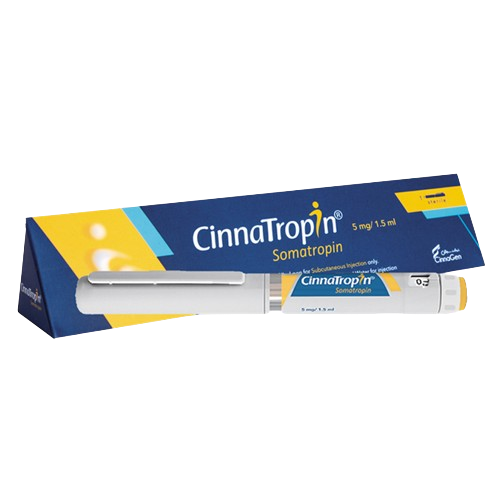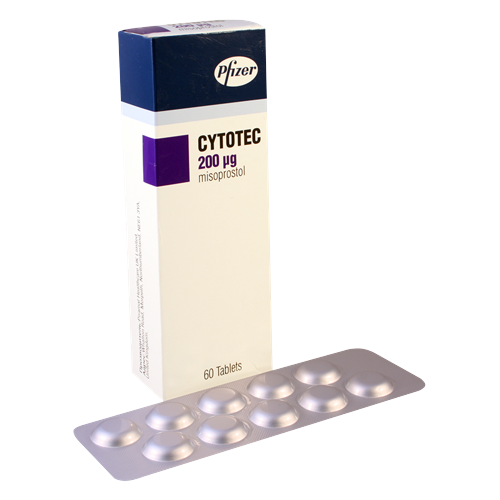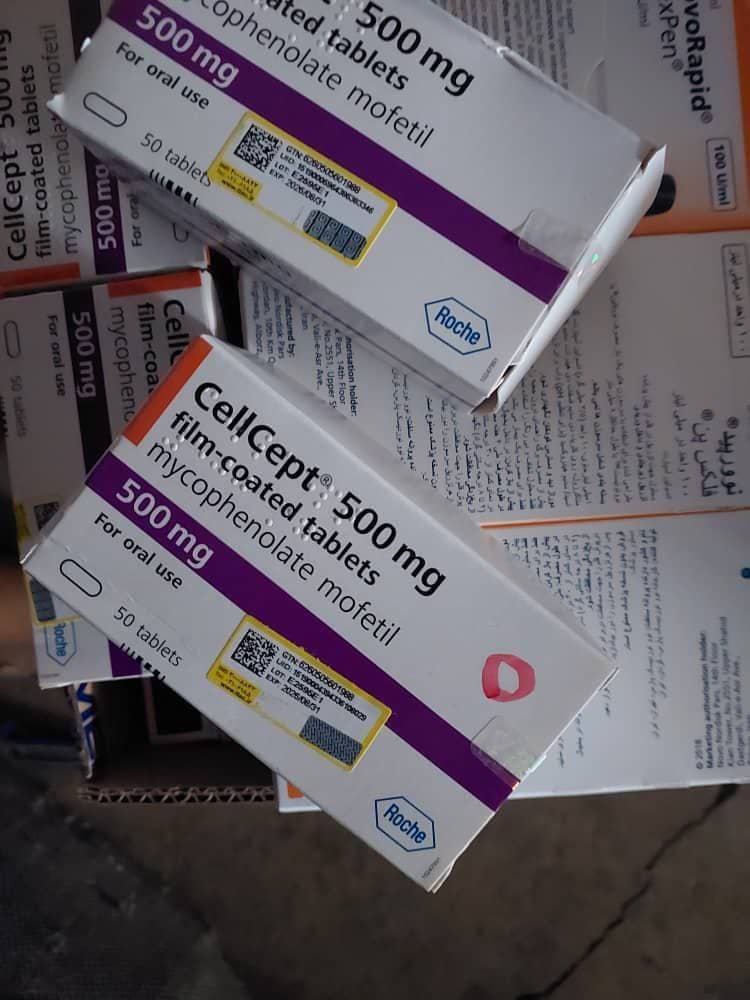Cinnatropin Somatropin 5mg/1.5ml Injection
Cinnatropin Overview
Cinnatropin is a brand of somatropin, a recombinant human growth hormone. It is produced by CinnaGen Company and is available in pre-filled pens.
Composition
- Dosage Form: Injection
- Concentration: 5mg/1.5ml or 10mg/1.5ml of somatropin
Indications
Cinnatropin is primarily indicated for:
- Pediatric Patients: Treatment of growth failure due to inadequate secretion of endogenous growth hormone.
- Adult Patients: Management of growth hormone deficiency.
Dosage and Administration
Pediatric Dosage
- Starting Dose: Up to 0.004 mg/kg subcutaneously once daily.
- Maximum Dose: Up to 0.016 mg/kg subcutaneously once daily (or 0.08 mg/kg per week in divided doses).
Administration Guidelines
- Route: Subcutaneous injection.
- Injection Sites: Alternate injection sites to minimize tissue irritation.
Monitoring and Supervision
- Specialist Supervision: Treatment should be managed by healthcare professionals experienced in growth hormone deficiency.
- Regular Monitoring: Patients should be monitored for growth response and potential side effects.
Important Considerations
- Storage: Cinnatropin should be stored in a refrigerator and protected from light.
- Side Effects: Potential side effects may include injection site reactions, headaches, and increased risk of diabetes.
Conclusion
Cinnatropin is an effective treatment for growth hormone deficiency in both pediatric and adult populations. Proper administration and monitoring are essential for achieving optimal therapeutic outcomes. Always consult healthcare professionals for personalized medical advice.

Original price was: ₨7,000.00.₨4,800.00Current price is: ₨4,800.00.
Description
Cinnatropin Overview
Cinnatropin is a brand of somatropin, a recombinant human growth hormone. It is produced by CinnaGen Company and is available in pre-filled pens.
Composition
- Dosage Form: Injection
- Concentration: 5mg/1.5ml or 10mg/1.5ml of somatropin
Indications
Cinnatropin is primarily indicated for:
- Pediatric Patients: Treatment of growth failure due to inadequate secretion of endogenous growth hormone.
- Adult Patients: Management of growth hormone deficiency.
Dosage and Administration
Pediatric Dosage
- Starting Dose: Up to 0.004 mg/kg subcutaneously once daily.
- Maximum Dose: Up to 0.016 mg/kg subcutaneously once daily (or 0.08 mg/kg per week in divided doses).
Administration Guidelines
- Route: Subcutaneous injection.
- Injection Sites: Alternate injection sites to minimize tissue irritation.
Monitoring and Supervision
- Specialist Supervision: Treatment should be managed by healthcare professionals experienced in growth hormone deficiency.
- Regular Monitoring: Patients should be monitored for growth response and potential side effects.
Important Considerations
- Storage: Cinnatropin should be stored in a refrigerator and protected from light.
- Side Effects: Potential side effects may include injection site reactions, headaches, and increased risk of diabetes.
Conclusion
Cinnatropin is an effective treatment for growth hormone deficiency in both pediatric and adult populations. Proper administration and monitoring are essential for achieving optimal therapeutic outcomes. Always consult healthcare professionals for personalized medical advice.
Key Benefits of Cinnatropin
Cinnatropin (somatropin) offers several significant benefits for patients with growth hormone deficiencies:
1. Muscle Growth Stimulation
- Promotes the development of lean muscle mass, aiding in overall physical strength.
2. Enhanced Protein Synthesis
- Improves the body’s ability to synthesize proteins, which is crucial for muscle repair and growth.
3. Improved Metabolism
- Increases metabolic rate, facilitating fat loss and better energy utilization.
4. Fat Loss Promotion
- Helps reduce body fat by enhancing lipolysis (the breakdown of fats).
5. Immune System Support
- Contributes to a stronger immune response, helping the body fend off infections.
Key Ingredient in Cinnatropin
Somatropin
- Type: Recombinant human growth hormone
- Concentration: Available in formulations of 5mg/1.5ml and 10mg/1.5ml
- Function: Essential for growth, cell reproduction, and regeneration, somatropin plays a critical role in bone and muscle development as well as metabolic processes.
Cinnatropin is produced by CinnaGen Company and is recognized for its efficacy and safety profile, making it a valuable option for managing growth hormone deficiencies.
Mechanism of Action of Somatropin (Cinnatropin)
Somatropin, the active ingredient in Cinnatropin, exerts its effects through the following mechanisms:
Binding to Growth Hormone Receptors
- Somatropin binds to the human growth hormone receptor (GHR), which is a dimeric receptor expressed in target cells in the liver and cartilage.
- Upon binding, GHR dimerizes and interacts with Janus kinase 2 (JAK2), leading to tyrosine phosphorylation of JAK2 and the GH receptor.
Activation of Signal Transduction Pathways
- The signal transducer activator of transcription (STAT) pathway is initiated, where transcription factors such as STAT1, STAT3, and STAT5 are translocated into the nucleus to stimulate target gene transcription.
Stimulation of Linear Growth
- At the epiphysis or growth plate, growth hormone increases linear growth by promoting differentiation of prechondrocytes and expansion of osteoblasts.
- Growth hormone binding to its receptor in the liver and cartilage promotes the production of insulin-like growth factor-1 (IGF-1), which acts on type 1 IGF receptors to also stimulate linear growth.
Regulation of IGF-1 and Binding Proteins
- In the liver, activated growth hormone receptor signaling leads to increased production of IGF binding protein-3 (IGFBP-3) and acid-labile subunit (ALS), which are proteins that bind to IGF-1 in a ternary complex to increase its half-life.

Chemical Structure of Somatropin (Cinnatropin)
Somatropin, the active ingredient in Cinnatropin, is a recombinant form of human growth hormone. Its chemical structure is characterized by the following:
Molecular Formula
- C: 39
- H: 60
- N: 8
- O: 13
Structural Characteristics
Somatropin is a polypeptide composed of 191 amino acids. Its structure includes:
- Peptide Bonds: The amino acids are linked by peptide bonds, forming a long chain that folds into a specific three-dimensional shape essential for its biological activity.
- Disulfide Bridges: The molecule contains disulfide bridges that stabilize its structure, contributing to its functional properties.
Biological Function
The unique structure of somatropin allows it to bind to growth hormone receptors, initiating signaling pathways that promote growth and metabolic functions in the body.

Key Precautions for Cinnatropin
When using Cinnatropin (somatropin), it is essential to consider the following precautions:
1. Contraindications
- Closed Epiphyses: Not recommended for pediatric patients with closed growth plates.
- Acute Critical Illness: Avoid use in patients experiencing complications from surgery, trauma, or respiratory failure.
- Active Malignancy: Should not be used in individuals with active cancer.
- Diabetic Retinopathy: Use is contraindicated in patients with active proliferative or severe nonproliferative diabetic retinopathy.
2. Pregnancy and Breastfeeding
- Inform your healthcare provider if you are pregnant, plan to become pregnant, or are breastfeeding, as the safety of Cinnatropin during these periods is not fully established.
3. Drug Interactions
- Discuss all medications, including over-the-counter drugs, vitamins, and herbal products, with your healthcare provider, as they may interact with somatropin.
4. Monitoring
- Regular monitoring of growth response and potential side effects is essential during treatment.
Dietary Restrictions
While specific dietary restrictions are not explicitly outlined for Cinnatropin, the following general guidelines are advisable:
1. Balanced Diet
- A well-balanced diet rich in nutrients can support overall health and growth, particularly in pediatric patients.
2. Blood Sugar Levels
- Patients with diabetes or those at risk should monitor carbohydrate intake, as somatropin can affect insulin sensitivity and blood sugar levels.
3. Consultation with Healthcare Provider
- It is advisable to consult with a healthcare provider or nutritionist for personalized dietary recommendations, especially if there are underlying health conditions.
Food and Supplement Interactions
1. Alcohol Interaction
- There is one documented interaction between somatropin and alcohol. It is advisable to limit alcohol consumption while using CinnaTropin due to potential effects on metabolism and overall health.
2. General Dietary Considerations
- While specific foods are not explicitly listed as interacting with CinnaTropin, maintaining a balanced diet is essential. Patients should be cautious with high-sugar foods, as somatropin can affect insulin sensitivity and blood sugar levels.
3. Supplements
- Certain supplements may interact with somatropin, including:
- DHEA (Dehydroepiandrosterone): May affect hormonal balance.
- Fish Oil (Omega-3 fatty acids): Potentially alters metabolism and insulin sensitivity.
- Multivitamins: Some components may interact, particularly those affecting hormonal pathways.
4. Consultation with Healthcare Provider
- It is crucial to discuss all dietary supplements and medications with a healthcare provider to avoid potential interactions. This includes over-the-counter medications, vitamins, and herbal products.
Drug Interactions with CinnaTropin
Overview of Interactions
CinnaTropin is known to interact with a total of 432 drugs, categorized as follows:
- Major Interactions: 3
- Moderate Interactions: 415
- Minor Interactions: 14
Commonly Checked Medications
Some frequently checked medications that may interact with somatropin include:
- Acetylsalicylic Acid (Aspirin)
- Adderall (Amphetamine/Dextroamphetamine)
- Aromasin (Exemestane)
- Ativan (Lorazepam)
- Cortef (Hydrocortisone)
- DHEA (Dehydroepiandrosterone)
- Fish Oil (Omega-3 Fatty Acids)
- Heparin Sodium
- Lexapro (Escitalopram)
- Synthroid (Levothyroxine)
Specific Interaction Effects
- Hypoglycemic Agents: Somatropin may decrease the effectiveness of certain diabetes medications, such as acarbose and acetohexamide, potentially leading to elevated blood sugar levels.
- Anticoagulants: The metabolism of anticoagulants like acenocoumarol may be increased when combined with somatropin.
- Pain Relievers: Acetaminophen metabolism may also be affected, which could alter its efficacy.
Disease Interactions
CinnaTropin has interactions with various diseases, including:
- Diabetes: Caution is advised due to potential effects on insulin sensitivity.
- Active Malignancy: Use is contraindicated in patients with active cancer.
- Diabetic Retinopathy: Patients with this condition should avoid somatropin.
Use During Pregnancy
- Safety: CinnaTropin is not generally recommended for use during pregnancy. The effects of somatropin on fetal development have not been adequately studied, and potential risks may exist.
- Consultation: Women who are pregnant or planning to become pregnant should inform their healthcare provider before starting treatment with CinnaTropin. It is crucial to evaluate the benefits versus risks in such cases.
Use During Breastfeeding
- Limited Data: The safety of CinnaTropin during breastfeeding is not well established. It is unclear how much somatropin passes into breast milk and its potential effects on a nursing infant.
- Healthcare Provider Guidance: Nursing mothers should consult their healthcare provider to discuss the appropriateness of using CinnaTropin while breastfeeding. Alternative medications may be considered that have a better-established safety profile during lactation.
Risks of Taking Cinnarizine During Pregnancy
1. General Recommendation
- Cinnarizine is not usually recommended for pregnant women. It is advisable to consult with a healthcare provider for alternative options that may be safer during pregnancy.
2. Lack of Comprehensive Studies
- There is limited data on the effects of cinnarizine on fetal development. As a result, the potential risks to the developing fetus are not fully understood, which raises concerns about its use during this critical period.
3. Consultation with Healthcare Providers
- Pregnant women should discuss their medical needs with their doctor or pharmacist if they are considering taking cinnarizine. Healthcare providers can offer guidance on safer alternatives and evaluate the potential benefits versus risks of using this medication during pregnancy.
4. Breastfeeding Considerations
- While cinnarizine can be taken while breastfeeding if the baby is healthy, its sedative effects may cause drowsiness in the infant. Therefore, occasional use is preferable, and mothers should monitor their babies for any unusual symptoms.
Use of Cinnarizine During Pregnancy
- Cinnarizine is generally not recommended for use during pregnancy unless the potential benefits outweigh the risks, as determined by a healthcare provider.
- The safety of cinnarizine during pregnancy has not been firmly established, and its potential effects on fetal development are not well-studied.
Potential Risks
- While there is no direct evidence linking cinnarizine to complications during childbirth, the lack of safety data during pregnancy raises concerns about its use.
- Cinnarizine may have sedative effects and could potentially impact the mother’s ability to participate in the birthing process.
Consultation with Healthcare Providers
- Pregnant women should always consult with their obstetrician or midwife before taking any medication, including cinnarizine.
- Healthcare providers can assess the individual risks and benefits and provide guidance on safer alternatives or appropriate dosing if cinnarizine is deemed necessary.

Dosage
The recommended dosage of cinnarizine varies depending on the indication:
- For vertigo, dizziness, tinnitus, nystagmus, nausea and vomiting:
- 25 mg tablet taken 3 times daily (TID) or
- 75 mg tablet taken once daily for maintenance therapy
- For motion sickness:
- 25 mg tablet taken at least half an hour before travelling
- One 25 mg tablet every 6 hours during the journey
The maximum recommended daily dose is 225 mg.
Storage
Cinnarizine should be stored in a cool, dry place protected from light.
Reviews
There are limited customer reviews available for cinnarizine itself. However, a study analyzing seven placebo-controlled, double-blind clinical trials found that cinnarizine at doses of 30-225 mg/day was well-tolerated, with the most common side effects being drowsiness and epigastric discomfort.








Salman Khan (verified owner) –
Bohot zabardast
Timely Dispatched aur payment wosool karty hue b jaldi nai ki bohot professionaly deal Kiya
GOOD EXPERIENCE Vitamins Collection
Salman Khan (verified owner) –
Nice experience